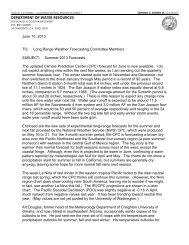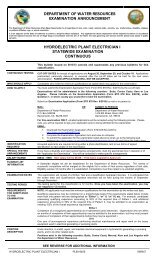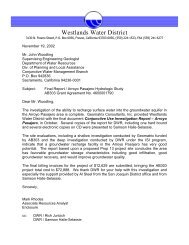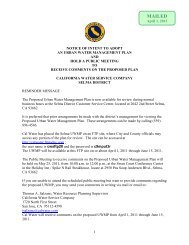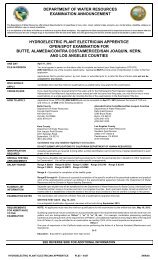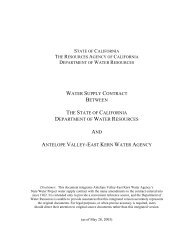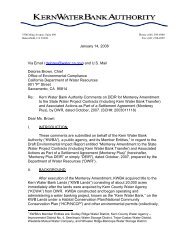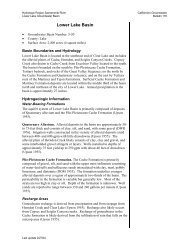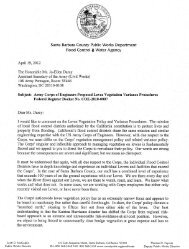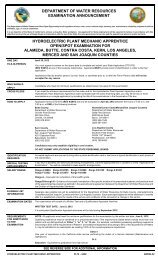Bulletin 1.pdf - California Department of Water Resources - State of ...
Bulletin 1.pdf - California Department of Water Resources - State of ...
Bulletin 1.pdf - California Department of Water Resources - State of ...
Create successful ePaper yourself
Turn your PDF publications into a flip-book with our unique Google optimized e-Paper software.
22 WATER RESOURCES OF CALIFORSIA<br />
"2. Such right does not extend to the waste <strong>of</strong> water.<br />
"3. Such right does not extend to unreasonable use or unreasonable<br />
method <strong>of</strong> use or unreasonable method <strong>of</strong> diversion <strong>of</strong> water.<br />
"4. Riparian rights attach to, but to no more than so much <strong>of</strong><br />
the flow as may be required or used consistently with this section <strong>of</strong><br />
the Constitution.<br />
"The foregoing mandates are plain, they are positive, and admit<br />
<strong>of</strong> no exception. The;r apply to the use <strong>of</strong> all water, under whatever<br />
right the use may be enjoyed. The problem is to apply these rules in<br />
the vaIJ-ing circumstances <strong>of</strong> cases as the;r arise. "<br />
During the last few years quality <strong>of</strong> water has become a matter <strong>of</strong><br />
vital concern to some areas <strong>of</strong> the <strong>State</strong>. Ithas long been common practice<br />
to discharge various sewage and industrial wastes into water sources and<br />
onto the land, thereby <strong>of</strong>ten impairing the quality <strong>of</strong> surface and ground<br />
water supplies. Local communities have made some efforts to cope with<br />
the problems thus created, but without great success. The need for effective<br />
action was finally brought sharply into focus by the tremendous<br />
expansion in industrial development during and since World War II.<br />
An increase in population <strong>of</strong> about 4,000,000 in the last decade intensified<br />
pollution damage, and the ever increasing threat to the quality <strong>of</strong><br />
their water supplies became a matter <strong>of</strong> grave anxiety to water users.<br />
As a result, under provisions <strong>of</strong> a series <strong>of</strong> laws enacted by the Legislature<br />
in 1949, the <strong>State</strong> has recognized the continuing threat <strong>of</strong> water pollution<br />
and assumed responsibility for maintaining the quality <strong>of</strong> its water<br />
resources. These acts created nine regional water pollution control boards<br />
and one state board, and endowed them with broad powers to control<br />
water pollution.<br />
THE CAUFORNIA WATER PROBLEM<br />
The over-all water problem <strong>of</strong> <strong>California</strong> is made up <strong>of</strong> many interrelated<br />
problems, some <strong>of</strong> which are mainly local while others are statewide<br />
in implication. Prior to the time when the southern part <strong>of</strong> <strong>California</strong><br />
had to turn to the Colorado River, and until rapidly receding<br />
ground waters in southern San Joaquin Valley brought about initiation<br />
<strong>of</strong> the Central Valley Project, water needs were met in most instances<br />
by some form <strong>of</strong> local action. It is now generally realized, however, that<br />
a greater measure <strong>of</strong> state leadership and participation in planning and<br />
construction is required if the water resources <strong>of</strong> <strong>California</strong> are to be<br />
properly controlled and utilized to meet rapidly increasing needs <strong>of</strong><br />
the people.<br />
From a state-wide point <strong>of</strong> view, redistribution <strong>of</strong> the water supply<br />
from areas <strong>of</strong> surplus to areas <strong>of</strong> deficiency provides the greatest challenge,<br />
especially in the northern and central portions <strong>of</strong> <strong>California</strong>. About<br />
two-thirds <strong>of</strong> the water is in the northern third <strong>of</strong> the <strong>State</strong>, whereas the<br />
greater demands--agricultural, industrial, and municipal-are in the<br />
central and southern portions. The solution <strong>of</strong> such a geographical problem<br />
must involve transportation and exchange <strong>of</strong> water, generally from<br />
north to south. It must include construction <strong>of</strong> surface storage reservoirs<br />
and utilization <strong>of</strong> the great ground water storage capacity <strong>of</strong> the valleys<br />
for regulating stream flow. Multiple-purpose basin and trans-basin developments<br />
will be required, involving many complex technical, financial,



